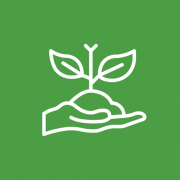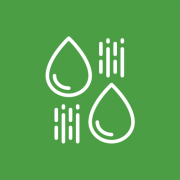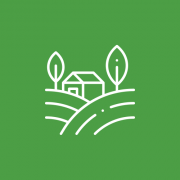Locally-Sourced, All Organic Ingredients
Organic Compost Topdressing
After years of traditional lawn care abuse, toxic fertilizers strip your lawns soil of vital nutrients. At Pure Solutions, our organic compost treatments returns the soil to its natural state and promotes an organically beautiful, green healthy yard.

What is Organic Topdressing?
View
Topdressing is the application of broadcasting a thin layer of soil over an existing lawn. Typically, applications range from ¼ inch to ½ inch of compost coverage.
The topdressing is worked into the soil by natural rainfall or by multiple irrigation cycles.
At Pure Solutions, we offer compost topdressing to our organic lawn care clients to help rejuvenate and feed the soil.

What Benefits Does Composting Provide?
Benefits
Topdressing’s benefits are numerous as it is the foundation for our organic lawn care program.
Pure Solutions Topdressing will:
- Improve soil biology by adding organic matter and beneficial microorganisms found in compost.
- Improve soil structure and drainage by topdressing with sand or other compost materials.
- Smooth out bumps caused by wear and worm castings while also encouraging a dense, lush lawn.
- Reduces lawn stresses, helps keep thatch under control and acts as a long-term natural fertilizer.
- Conserve water by acting like a sponge and allowing your turf to hold more water, especially in dry months.
- Aid in the recovery from foot traffic. Lawn compaction starves the roots of your lawn of oxygen, water and nutrients. Organic compost ensures immediate nutrient availability and introduces microbes that help loosen compaction.
- Reduce incidences of disease by adding beneficial microbes and nutrients to the soil of your lawn, creating a stronger root system and a more durable healthy lawn.
- Create an optimal seedbed for fast generation. Warm soil with moderate day temperatures and cool evenings is best for new grass growth. Compost helps facilitate these conditions by retaining moisture around the seed needed for germination.
At Pure Solutions Organic Compost Topdressing is Simple.

We Source Local For All Our Compost Needs
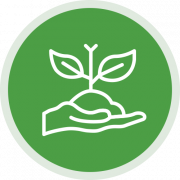
Absolutely No Bio-solids

All Organic Ingredients

Regular Quality Testing
Why You Should Make the Switch
- Every year millions of pounds of harmful, toxic pesticides are used across the United States on home lawns.
- According to the EPA, traditional lawn chemicals can put children and pets at risk.
- Healthy Organic lawns can help offset climate change by sequestering carbon dioxide.
- Organic lawns use less water.
- No leaching of chemicals into valuable drinking resources.
- Organic lawns are more stress tolerant.
Get a Digital Quote Today!
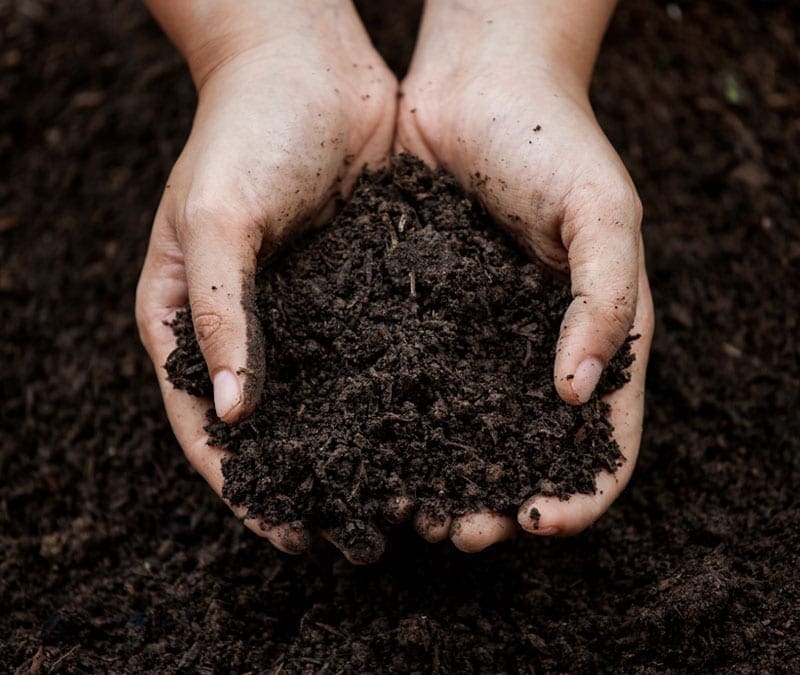
Pure Solutions Compost Composition
At Pure Solutions, our compost is made from the appropriate ratios of wet and dry materials and is fully “cooked” (highly decomposed).
Our high-quality finished compost is dark and rich and contains a variety of organic materials with few types of fillers such as sawdust and loam.
We use only the highest grade leaf compost in our all natural lawn care program, which is certified organic. We have a strict policy that biosolids (human feces) are not allowed in our compost due to the heavy metals and possible leaching into waterways and the lack of long term testing on the effects to the environment and humans.
How We Top Dress a Lawn
Traditionally, topdressing is spread over the turf by the shovelful, using a sweeping motion aimed at spreading the material as evenly as possible to a depth of 1/4 to 1/2 inch. This is followed by lightly raking the lawn to ensure that the topdressing is evenly distributed.
Our organic lawn care top dressing program utilizes power spreaders that consist of a hopper to hold the material and a motorized belt to move the material to a spinning disc that spreads it throughout the lawn. This provides the best uniform application for our customers and their lawns.
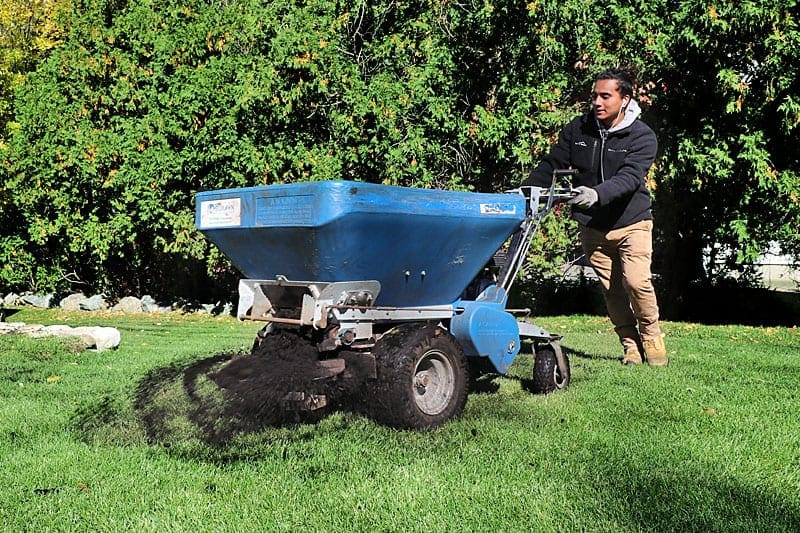
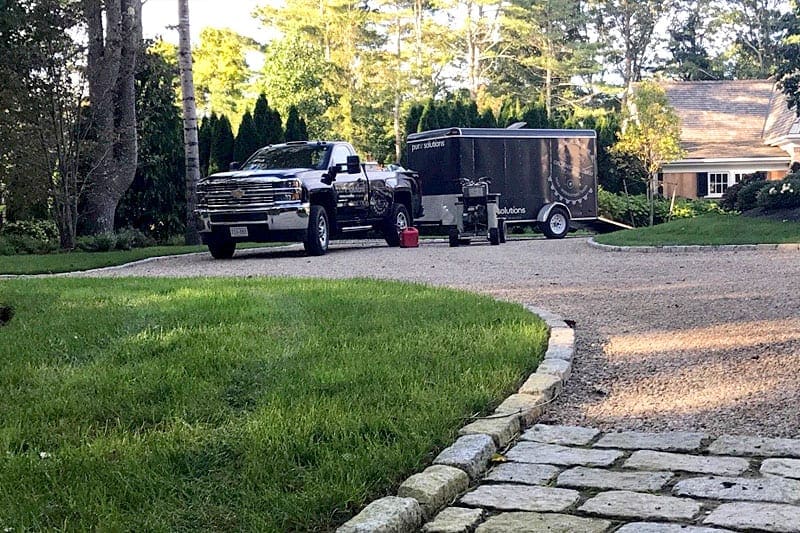
Application
It’s best to perform topdressing in conjunction with other cultural practices, such as aerating, dethatching, and overseeding.
We offer topdressing in the spring and fall during both seeding events. By utilizing both times of the year we give your lawn the nutritional and physical benefits of compost when it’s needed most.
Frequently Asked Questions
How to spread compost on lawn?
To spread compost on your lawn, start by choosing the right time, which is during the growing season when the grass is actively growing. Then, prepare the lawn by mowing it to a shorter length than usual and removing any debris. Next, use a spreader to distribute the compost evenly over the lawn, making sure to cover all areas. At Pure Solutions we offer high quality compost with machine powered spreaders for optimal results.
How much compost to topdress lawn?
The amount of compost to topdress your lawn can vary depending on factors such as the size of your lawn and the condition of the soil. As a general rule of thumb, it's recommended to apply a layer of compost that is no more than 1/2 inch thick. This will help to improve soil health, encourage healthy grass growth, and provide nutrients to your lawn. However, if your lawn has particularly poor soil quality, you may need to apply a thicker layer of compost, up to 1 inch, to see significant improvement. It's important to avoid applying too much compost, as this can smother your grass and cause other problems.
Can you use compost to level lawn?
Compost is not recommended for leveling a lawn due to several reasons. Firstly, as an organic material, compost can decompose over time, causing an uneven surface. This can defeat the purpose of leveling the lawn, which is to achieve an even surface. Secondly, compost may not provide the right balance of nutrients for the soil, which can lead to nutrient imbalances and harm the grass. Additionally, compost can retain water, leading to drainage issues, which can be harmful to the grass and may result in the growth of mold and fungus. Finally, applying compost evenly can be challenging, which can be time-consuming and labor-intensive.
When should I spread compost?
In general, the best time to spread compost on your lawn is during the fall or spring when the grass is actively growing. This allows the nutrients in the compost to be easily absorbed by the grass, promoting healthy growth. If you live in a warm climate, you can spread compost in the winter, as long as the ground is not frozen. However, if you live in a cold climate, it's best to wait until the ground thaws in the spring before spreading compost. It's important to note that you should not spread compost on your lawn during the hot summer months as it can burn the grass. Also, avoid spreading compost when the soil is waterlogged or saturated with moisture as it can lead to waterlogging and potential damage to the lawn.
Should compost go on top of soil?
Compost is a nutrient-rich material that is created by decomposing organic waste such as food scraps, yard trimmings, and leaves. When used in gardening or agriculture, compost provides essential nutrients to plants, improves soil structure, and helps retain moisture. Applying compost on top of the soil can have several benefits. First, it acts as a natural fertilizer, providing a slow-release source of nutrients to plants. Second, it improves the soil's water-holding capacity, reducing the need for frequent watering. Finally, it helps control weed growth by suppressing weed seeds that may be present in the soil. By adding compost on top of the soil, gardeners can create a healthy and sustainable growing environment for their plants while reducing the need for synthetic fertilizers and pesticides.
Pure Solutions offers New England’s #1 organic lawn care services, including organic lawn fertilizer service, lawn seeding services, lawn aeration service, and grub prevention & control services. Pure Solutions also proudly offers all natural tick control and mosquito control, all-natural deer repellent, botanical pest control products, special event pest control, and even commercial snow plowing. We serve locations across New England including Central New Hampshire, Upper Valley, Rhode Island, and Massachusetts, including Cape Cod and Martha’s Vineyard.



